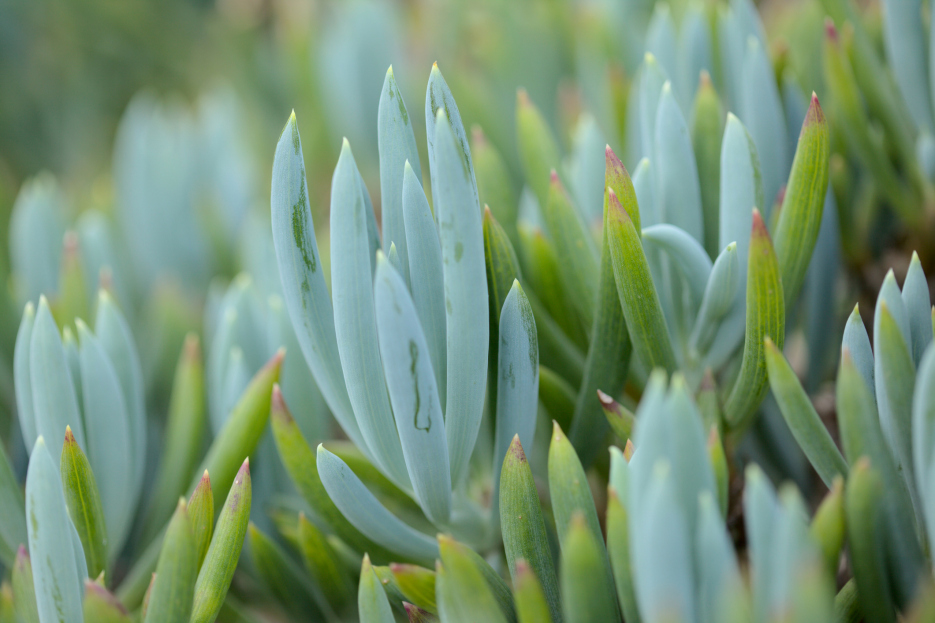
Curio repens, commonly known as Blue Chalksticks, is a striking succulent native to South Africa. With its trailing habit and vibrant blue-green leaves, this plant is perfect for hanging baskets, containers, or as a ground cover in gardens. Known for its low-maintenance needs, Blue Chalksticks is an ideal plant for succulent lovers and beginners alike. If you’re looking to add a beautiful, easy-care succulent to your collection, here’s everything you need to know about caring for Curio repens (Blue Chalksticks).
Blue Chalksticks thrive in bright, indirect sunlight. Like most succulents, they require ample light to grow well and maintain their vivid blue-green color. A south- or west-facing window is ideal for growing them indoors. If you’re growing Curio repens outside, choose a location with partial sun, where the plant can get a few hours of direct morning sun but is shielded from the harsher midday heat.
If your plant becomes leggy or starts to stretch out, it’s likely a sign that it’s not getting enough light. To remedy this, move the plant to a brighter location, and make sure it receives at least 4-6 hours of indirect sunlight each day.
Blue Chalksticks, like other succulents, are highly drought-tolerant and do not need frequent watering. Overwatering is one of the leading causes of problems with succulents, as it can lead to root rot. To ensure your plant remains healthy, it’s important to water it properly.
Tip: Avoid letting your plant sit in water. Ensure the container has proper drainage to prevent water from pooling in the bottom, which can lead to root rot.
Blue Chalksticks prefer warm temperatures and thrive in environments that range from 65°F to 85°F (18°C to 29°C). They are not frost-tolerant, so it’s important to bring them inside during the colder months or plant them in a climate zone that stays warm year-round (USDA zones 9-11).
As for humidity, low humidity is ideal for Curio repens. It doesn’t need high humidity to thrive and actually does better in dry air. In fact, excessive moisture in the air can lead to fungal problems and rot. Normal indoor humidity levels are perfect for Blue Chalksticks, but if you're growing it outdoors, make sure it’s placed in a spot with good air circulation to avoid moisture buildup.
Curio repens is a light feeder and does not require frequent fertilization. However, during the growing season (spring and summer), providing it with the right nutrients can help it grow vigorously and retain its attractive blue-green color.
Curio repens is relatively easy to maintain and only requires occasional pruning to keep it looking tidy.
Curio repens is very easy to propagate, making it a great choice for expanding your succulent collection or sharing with friends.
Tip: If you’re propagating several cuttings, you can place them together in one pot to create a fuller, more robust plant.
Yes, Curio repens (Blue Chalksticks) is non-toxic to pets. This makes it a safe plant for households with cats and dogs. However, as with any plant, it’s best to keep your pets from chewing on the leaves, as some animals might experience mild digestive upset if they ingest large amounts.
Q: Why are my Blue Chalksticks turning yellow?
A: Yellowing leaves are often a sign of overwatering or poor drainage. Check the soil moisture and make sure the plant is not sitting in water.
Q: Can I grow Curio repens outdoors?
A: Yes, Curio repens can be grown outdoors in USDA hardiness zones 9-11. Just make sure it’s protected from frost and planted in a location with good air circulation and partial sunlight.
Q: How often should I water my Blue Chalksticks?
A: Water your Blue Chalksticks when the top 1-2 inches of soil are dry. In the summer, this may be every 7-10 days, but reduce watering in winter.
Q: How fast does Curio repens grow?
A: Curio repens grows at a moderate pace, typically adding a few inches of growth each month during the growing season. It’s a slow grower during the cooler months.
Q: Can I propagate Blue Chalksticks from leaves?
A: Propagating from stem cuttings is the most reliable method. Leaf propagation is possible but not as successful with this plant.